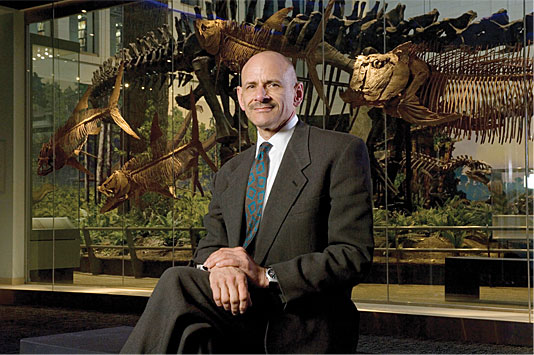 Fall 2010
Fall 2010|
“Our goal is to ensure that the exceptional and unique assets of the museum’s collections and the world-class talents of our scientists are applied to advance our understanding
of how life evolved. ” |
 Photo: Tom AltanyWhen the Society of Vertebrate Paleontology convenes its annual meeting here in October, Pittsburgh will be playing host to a group of some very busy people. The chief job of a paleontologist is, after all, to discover and describe extinct species—and there are so many yet to be discovered! It is generally assumed that 99.9 percent of all species that have ever existed are now extinct. The number of existing species is estimated to be 10 million to 100 million, and for the purposes of my calculation I’ll pick biologist Terry Erwin’s guesstimate of 30 million—which leaves us with around 30 billion extinct species. It’s a wonder paleontologists have any time to attend conferences. In the cover story, Rock Stars, you’ll read about paleontologists’ many amazing scientific pursuits—including the study of how life on Earth has responded to past episodes of climate change, the causes of mass extinctions, and the makeup of entire ecosystems that existed millions of years ago. These issues have immense relevance to present-day life because the factors that have affected the evolution of life are no different from the factors that will affect the future of life. As the great Russian geneticist Theodosius Dobzhansky once famously wrote, “Nothing in biology makes sense except in the light of evolution.” Carnegie Museum of Natural History has a huge stake in supporting the work of paleontologists and the science of evolution. Since the museum’s earliest days, paleontology has enjoyed a strong focus, with resources allocated to collecting fossils, supporting paleontology research, creating exhibitions, and offering educational programs that advance the public understanding of evolution. Moving forward, one way we will continue to support this aspect of the museum’s mission is through the creation of a Center for Evolutionary Biology, which will coordinate both our scientific research in evolution and our educational efforts, and also advocate for attracting the funding we need to sustain these efforts. In the coming years, our commitment to evolution education will also be evident in a series of fascinating exhibitions. The first of these, on display now through January 9, 2011, is Frans Lanting’s epic photographic project Life: A Journey Through Time, which interprets the story of life on Earth, from the first single-celled organisms to today’s vast array of life forms. Next year, we will host Explore Evolution, an interactive exhibition focused on seven research projects that have made major contributions to our understanding of the processes of evolution, including the rapid evolution of HIV and the genetic ties between humans and chimps. Then, in 2012, we will present Charlie and Kiwi’s Evolutionary Adventure, where visitors will join Charlie as he travels back to the age of the dinosaurs to discover the kiwis’ ancestors and evidence of how evolution works, including the evolutionary connections between dinosaurs and birds. Our goal with these engaging exhibitions, as with our planned Center for Evolutionary Biology, is to ensure that the exceptional assets of the museum’s collections and the world-class talents of our scientists are applied to advance our understanding of how life evolved. This knowledge is critical to answering the challenge of how life, in all its diversity, can be sustained into the future. An equally critical goal is fulfilling our mission of inspiring young minds to become the paleontologists of the future—the very folks who will have to struggle to find the time in their busy schedules to attend meetings of groups like the Society of Vertebrate Paleontology, who we welcome to Pittsburgh this October. |
Also in this issue:
Rock Stars · Ordinary Madness · A Nut on the Plane: Marilyn in Midflight · Hubble Vision · NewsWorthy · Face Time: Mike Hennessy · Science & Nature: Winging It · Artistic License: Opening the Book on André Kertész · Field Trip: Warhol in Coffee Country · The Big Picture
 |
Copyright © 2017 CARNEGIE Magazine. All rights reserved. |
